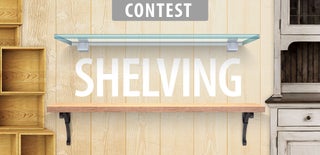Introduction: How to Make a Corner Shelf
We made this corner shelf for the Shelving, Papercraft and Trash To Treasure contests, it is made out of off cuts of wood I collected from building sites that would have been heading to the trash pile and pallet wood. It is finished with decoupage and gold infused plum chalk paint.
We made two companion videos that go with this Instructable for our channel BCDesign which should help you to make your own corner shelf!
The tools I used were:
- Table saw
- Drill
- Mitre saw
- Kreg jig r3
- Nail gun
- Sander
- Router
- Sponge Brushes
- Paint Brushes
Other Items:
- Wood glue
- Pva glue
- Pocket hole screws
- Water based lacquer
- Chalk paint
- Gold flake
- Sheet of Plastic
- Good quality brush.
Step 1: Search You're Trash to Treasure Pile for Materials
I had been collecting off cuts and pallet wood for nearly a year so I had built up a nice little collection. I looked through the pile and selected 3 long pieces of 3/4" mdf, a small square of 3/4" plywood and half a pallet for this project.
I just got a table saw so this was the perfect project to use it in!
Step 2: Cut the 2 Side Pieces & 4 Shelves
- I cut two pieces of mdf for the sides of the shelf, I then set my table saw to 45o and cut the front edge of each side piece so that I will be able to add a face frame.
- I cut 4 triangles to use as the top bottom & 2 shelves from a third piece of mdf.
- These triangles need to fit inside the sides flush with the front of the shelf.
- Due to the fact I am using pocket holes to join the sides, I need to butt joint the the side pieces.
- To make the sides equal when butt jointed I need to cut 3/4" of the back of one of the sides.
Step 3: Add Pocket Holes & Join Sides + Shelves
- I made a mistake here and drilled pocket holes along the inside of the shelf instead of the outside, they will be hidden by decoupage later so it is not a big deal.1one
- It is much easier to make your pocket holes on the back of the side pieces where they will never be seen, I also made pocket holes in the 4 triangular pieces for the top bottom an middle shelves, I then joined them to together with screws and glue.
- I used a piece of mdf and a speed square to made sure the shelves were screwed and glued into place equally.
- Now you have the main body of your shelf joined together
- I filled all the pocket holes and allowed the filler to dry before sanding it.
Step 4: Break Down Pallet & Cut Into 2" & 3/4" Strips
- I used a hatchet to knock some boards off a pallet
- I cut 2, 2"X3/4" strips and 2 3/4"x3/4" strips off the pallet wood on my table saw.
- I then glued and nailed the 2" strips to outside parts of the shelves
- Cut the 3/4"x3/4" strips to size and glue and nail them to the front of each shelf.
Step 5: Make the Base
- Cut a 3" strip of pallet wood for the base of the shelves
- The front of the base should be 3/4" back from the face frame
- Measure and cut the the strip of pallet wood on the mitre saw with 45o angles on the front edge of the the 2 side pieces
- Glue and nail the base together,I left a gap at the back corner of my base as the floor was not level, this will help it fit flush with the wall
- I nailed the base on from the inside of the bottom shelf and filled the holes left behind
Step 6: Make the Top + Pallet Wood Trim
- We used a plywood off cut to make the top
- I used the mitre saw to cut the square of plywood into a piece big enough to leave a 1/4" over hang of the face frame as I will be adding a 1/2" trim piece to hide the edge of the plywood.
- Use a router with a guided round over bit to make a trim piece from pallet wood, watch the 1 minute tip video below to see how I did this
Step 7: Apply Mdf Sealer
- I used an mdf sealer to prepare the mdf for a primer coat and chalk paint, the sealer helps prevent the mdf soaking up a lot of paint and leaving an unsightly appearance
- Your shelf is now ready for paint and decoupage!
Step 8: Paint the Area to Be Decoupaged
- We used some good quality primer to paint the areas to be decoupaged.
- Primer provides a good surface for the pva glue to adhere to when sticking the napkins onto the shelves.
- Speed up the drying process by using a hairdryer on low heat.
Step 9: Decoupage!
- Mix a small batch of 1/2 pva glue 1/2 water, we like to use a foam brush to apply it.
- Get the napkin and use a rulers edge and a paint brush to make a damp line where you need to tear your tissue to fit the shelf.
- Gently tear the napkin, when you have the piece you need ready dampen all the edges and pull little pieces of the paper away, these edges will be where all the joints meet and making them rough will avoid any unsightly lines.
- If the napkin is made of multiple layers of paper remove all the layers leaving just the top, this makes the paper much easier to work with.
- Apply the paper to the area after you have brushed on the pva water mix.
- When placing the paper use a plastic sheet between your hands and the paper as this will prevent the paper from tearing.
- When the shelves are all covered we applied a layer of pva/water mix to the surface of the paper.
- Use the hairdryer to help this dry faster.
Here is a quick 1 minute Instagram tip video of the decoupage process
Step 10: Chalk Paint & Lacquer Infused With Gold
- This corner shelf will be going in an all white guest bathroom so we decided to go with a nice plum chalk paint on this project.
- Buy a good quality chalk paint brush for applying the paint. I find this helps stop streaks being left in the paint.
- We masked off the decoupaged area and painted the corner shelf.
- You can once again use the hairdryer to help the chalk paint dry.
- When the chalk paint is dry, mix some water based lacquer with gold flake
- we applied 2 coats of the water based lacquer and gold flake finish!
Step 11: Finished!!!
This was a really enjoyable shelving project and it feels great to be able to use wood that was destined for the skip to make something beautiful for our home! It was also our first time trying a paper craft like decoupage and it wont be our last!
Please check out both the videos, subscribe and share if you like them! Please vote for us in the contests we entered!

Participated in the
Shelving Contest 2016

Participated in the
Trash to Treasure Contest 2017

Participated in the
Papercraft Contest 2017













